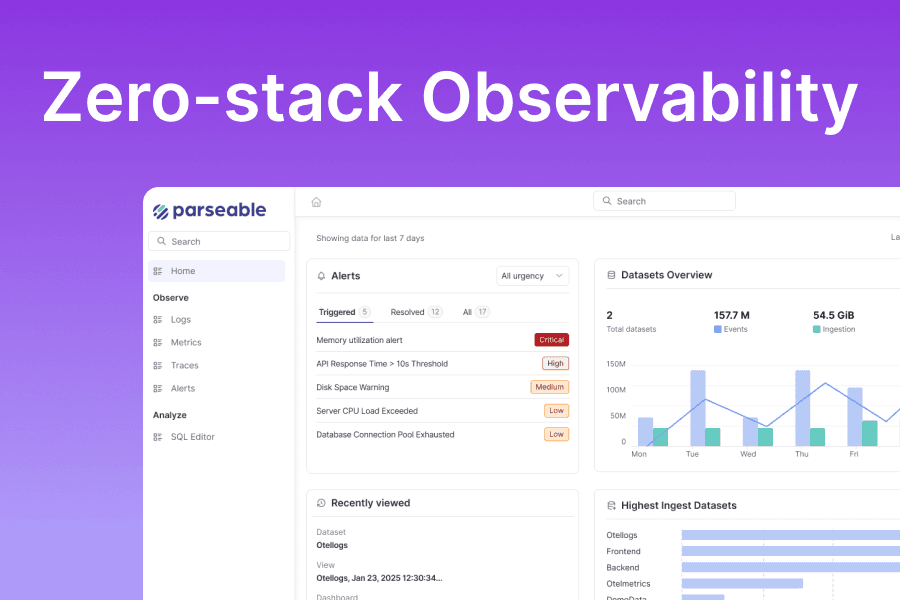Syslog is the abbreviation for System Logging Protocol. It is a logging method that allows monitoring and managing logs from different parts of the server or system. The primary use of Syslog data is to trace back errors in case of a failure or event. It can also be used to get information about your system's overall performance.
This Syslog guide will help you understand how it works and its functionality. Let's begin by understanding what it is and how it evolved.
History and Evolution of Syslog
The journey of Syslog began in the early days of the Unix operating system where it served as a simple logging protocol for capturing system messages. Eric Allman created the first instance of Syslog in the late 1980s. Soon it became a must-have tool for Unix administrators. The growing need for a standard logging protocol eventually led to the publication of RFC 3164 the first Syslog standard. It has been further developed and extended into RFC 5424 to establish a more solid and in the meantime flexible basis for the frameworks of message formats that could be used with Syslog.
3 Core Components of Syslog
At its core Syslog consists of several key components and concepts:
-
Syslog Daemon: The Syslog daemon is responsible for receiving processing and forwarding Syslog messages. Some examples of Daemons include Syslog
rsyslogorsyslog-ng. It is the central hub for logging activities. Hence it helps capture and appropriately handle all system events along with log data. -
Syslog Messages: A typical Syslog message is made up of three parts:
- The priority (PRI)
- Header
- Message (MSG)
The PRI combines facility code and severity indicating the message's source and importance. The header includes a timestamp and the hostname or IP address while the MSG contains the log message or event data.
- Facilities and Severities: Syslog categorizes messages by facilities such as
kern(kernel messages)user(user-level messages) andmail(mail system). Severities range fromemergency(system unusable) todebug(debug messages) allowing administrators to filter and prioritize log data effectively.
How Syslog Works
Syslog operates through a straightforward yet powerful workflow:
- Message Flow: Applications generate Syslog messages which are transported over networks using protocols like UDP (User Datagram Protocol) or TCP (Transmission Control Protocol). Upon arrival the Syslog or log server processes and stores these messages according to configured rules.
- Syslog Formats: The most common standard Syslog message formats include
RFC 3164andRFC 5424. RFC 3164 is the original Syslog format and is widely supported. The RFC 5424 offers enhanced features including structured data and better timestamp precision.
Benefits of Using Syslog
Several key benefits drive Syslog's widespread adoption.
- Centralized Logging: By aggregating logs from multiple sources into a central location Syslog simplifies monitoring and management. This centralized approach enhances visibility and enables more efficient analysis of log events.
- Real-time Monitoring: Syslog supports real-time alerting and Syslog monitoring allowing administrators to detect and respond to issues promptly. This capability is crucial for maintaining system uptime and security across network devices.
- Compliance and Auditing: Syslog helps organizations meet regulatory requirements by providing a reliable and tamper-evident logging mechanism. It facilitates auditing and records all critical events in the log file.
- Troubleshooting: Syslog's detailed and structured logs are invaluable for troubleshooting. By examining log messages administrators can more efficiently identify and resolve issues minimizing downtime and disruption.
Syslog Configuration and Usage
Configuring Syslog involves setting up the Syslog daemon and integrating it with various Syslog tools:
Configuring Syslog Daemon
Basic configuration typically involves specifying log file locations setting log rotation policies and defining message filtering rules. Advanced configurations can include:
- Forwarding logs to a central Syslog server
- Applying TLS/SSL for secure transmission
- Customizing log formats
Common Syslog Tools
Syslog provides the ability to use tools to enhance performance. One of the most famous tools is RSyslog. It is known for its high performance and flexibility and as a result it is widely preferred in modern Linux environments. Syslog-ng offers advanced features like content-based filtering and high-availability clustering. Moreover if you integrate Syslog with log management systems such as Parseable it provides powerful analytics and visualization capabilities.
Best Practices for Syslog
To maximize Syslog's effectiveness administrators should follow these best practices:
Security
Ensure secure transmission of Syslog messages using TLS/SSL. This prevents unauthorized access and protects the integrity of log data.
Performance
Optimize Syslog performance by fine-tuning buffer sizes configuring appropriate log rotation policies and using efficient storage solutions.
Scalability
Plan for scalability by distributing logging workloads across multiple servers and using load-balancing techniques. This ensures that Syslog can handle large volumes of logs in high-demand environments.
Maintenance
Regular maintenance tasks include:
- Monitoring disk usage
- Checking for log file corruption
- Updating Syslog configurations as needed
This proactive approach helps maintain a healthy logging infrastructure.
Challenges and Limitations of Syslog
Despite its benefits Syslog faces several challenges:
- Reliability Issues: UDP-based transport while fast can be unreliable leading to potential message loss. Using TCP or implementing reliable delivery mechanisms can mitigate this risk.
- Scalability Concerns: Handling large volumes of logs requires careful planning and resource allocation. Implementing distributed logging solutions and efficient indexing can help address scalability challenges.
- Complexity: Managing complex Syslog configurations can be daunting. Clear documentation regular audits and leveraging automation tools can simplify configuration management.
Future of Syslog
Syslog continues to evolve adapting to modern IT environments:
- Emerging Trends: New developments in logging technologies such as structured logging and enhanced metadata support are enhancing Syslog's capabilities and driving improvements in log analysis and correlation.
- Integration with Modern Systems: Syslog is increasingly integrating with cloud-native and containerized environments. This includes support for logging drivers in Docker and Kubernetes enabling seamless logging across diverse infrastructures.
Conclusion
Syslog remains a fundamental tool for system logging offering numerous benefits for IT professionals. Administrators can leverage Syslog to enhance system monitoring compliance and troubleshooting by understanding its history core concepts and best practices. Syslog adapts as the logging landscape evolves ensuring its relevance in modern computing environments.
Read next: How to Setup Syslog

